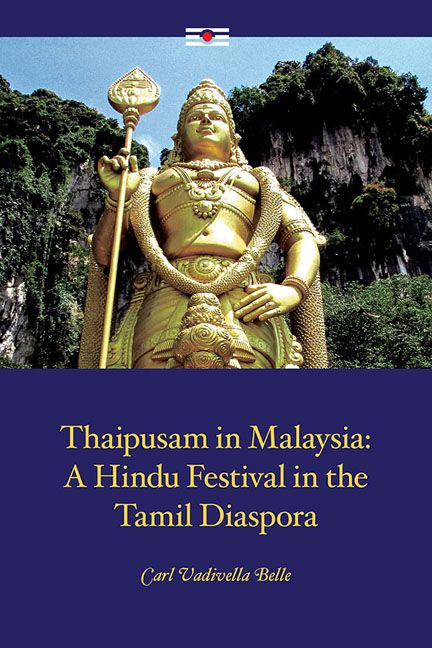Book contents
- Frontmatter
- Contents
- Acknowledgements
- Introduction
- 1 Indians in Malaysia: The Social and Ethnic Context
- 2 Tamil Traditions and South Indian Hinduism
- 3 Colonialism, Colonial Knowledge and Hindu Reform Movements
- 4 Hinduism in Malaysia: An Overview
- 5 Murugan: A Tamil Deity
- 6 The Phenomenology of Thaipusam at Batu Caves
- 7 Other Thaipusams
- 8 Thaipusam Considered: The Divine Crossing
- Conclusions
- Glossary
- Bibliography
- Index
- About the Author
6 - The Phenomenology of Thaipusam at Batu Caves
Published online by Cambridge University Press: 12 January 2018
- Frontmatter
- Contents
- Acknowledgements
- Introduction
- 1 Indians in Malaysia: The Social and Ethnic Context
- 2 Tamil Traditions and South Indian Hinduism
- 3 Colonialism, Colonial Knowledge and Hindu Reform Movements
- 4 Hinduism in Malaysia: An Overview
- 5 Murugan: A Tamil Deity
- 6 The Phenomenology of Thaipusam at Batu Caves
- 7 Other Thaipusams
- 8 Thaipusam Considered: The Divine Crossing
- Conclusions
- Glossary
- Bibliography
- Index
- About the Author
Summary
In the previous chapter we examined the mythology surrounding the deity Murugan — his creation, his spiritual maturation, his acquisition of the Vel, and his defeat of the asuric army headed by the demon Surapadman. It specifically noted his adaptation and emblematic role as a quintessentially Tamil deity. As we have observed, the festival of Thaipusam commemorates a specific and determining event in the deity's cosmology, namely Parvati's bestowal of the Vel upon Murugan as the weapon he will use to defeat the asuric army. This chapter will examine the conduct of the festival of Thaipusam at Batu Caves, located outside Kuala Lumpur. While Batu Caves is the major Malaysian centre in which Thaipusam is commemorated, there are other significant pilgrimage sites, both in Peninsular and East Malaysia, where the festival is observed.
The first section will trace the founding and development of Batu Caves as Malaysia's foremost Murugan pilgrimage site. It will also detail the current layout of the caves compound. This not only contains the main shrine to Murugan, but also incorporates a number of supplementary temples, an administrative building, a cultural complex including a museum (Muzium) and a gallery, a Tamil school and retail outlets.
The following section will explore the overall structure of the festival. This will emphasize the chariot procession from the Sri Maha Mariamman Kovil (temple) to Batu Caves, the ceremonial visit of the deity Murugan to his Batu Caves shrine, the installation of the Golden Vel in his mountaintop temple, and his subsequent return to his main abode in central Kuala Lumpur. The section will emphasize the centrality of the chariot procession and its general linkages to the rituals associated with South Indian kingship.
The final section focuses upon the kavadi ritual as one of the defining features of Thaipusam at Batu Caves. Many scholars have pointed out that myths only reveal their potency and inner truths, their “transformative capacity to reveal the ways in which the invisible is enfolded within the visible”, when they are re-enacted within ritual. The previous chapter examined the mythology of Idumban, outlining the legitimating model for the kavadi ritual and highlighting the transformative power of asceticism and yogic disciplines.
- Type
- Chapter
- Information
- Thaipusam in MalaysiaA Hindu Festival in the Tamil Diaspora, pp. 185 - 243Publisher: ISEAS–Yusof Ishak InstitutePrint publication year: 2017



